Microeconomics Homework: Analyzing Market Structures and Profits
VerifiedAdded on 2022/09/01
|10
|2244
|22
Homework Assignment
AI Summary
This microeconomics assignment delves into various aspects of market structures and profit analysis. It begins by defining and differentiating between accounting profit, economic profit, and normal profit, emphasizing their importance for business sustainability. The assignment then explores the impact of changes in demand and supply on market prices and industry profits, using the example of emu meat. It further examines market entry and exit barriers, the long-run behavior of competitive industries, and the transition from perfect competition to monopoly within the lawn mowing industry. The analysis includes graphical representations and comparisons of market outcomes under different structures. Finally, the assignment discusses monopolistic competition and oligopoly, analyzing the impact of product differentiation, market power, and collusion on firm behavior and profit maximization. The assignment provides a comprehensive understanding of microeconomic principles and their practical applications in various market scenarios.
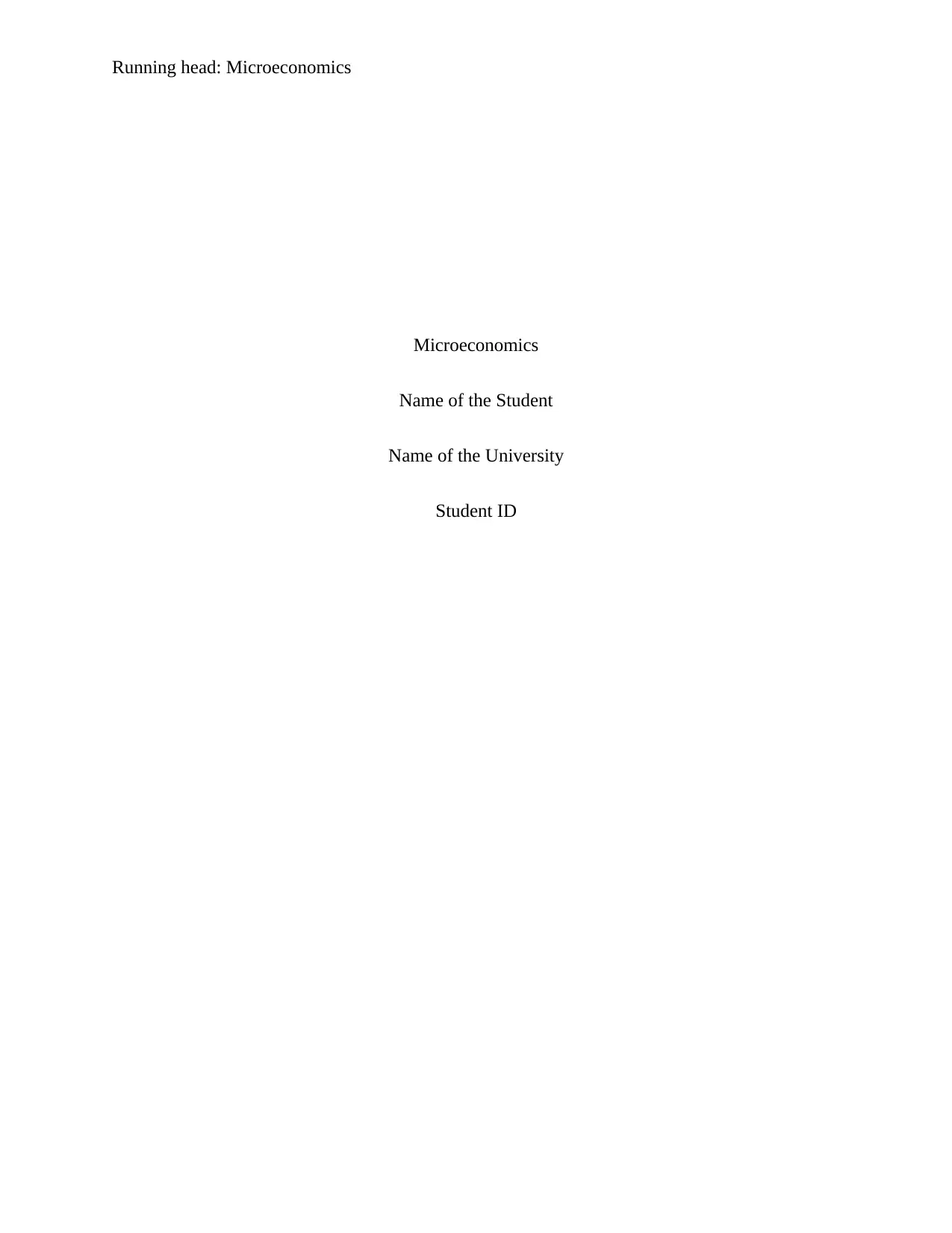
Running head: Microeconomics
Microeconomics
Name of the Student
Name of the University
Student ID
Microeconomics
Name of the Student
Name of the University
Student ID
Paraphrase This Document
Need a fresh take? Get an instant paraphrase of this document with our AI Paraphraser
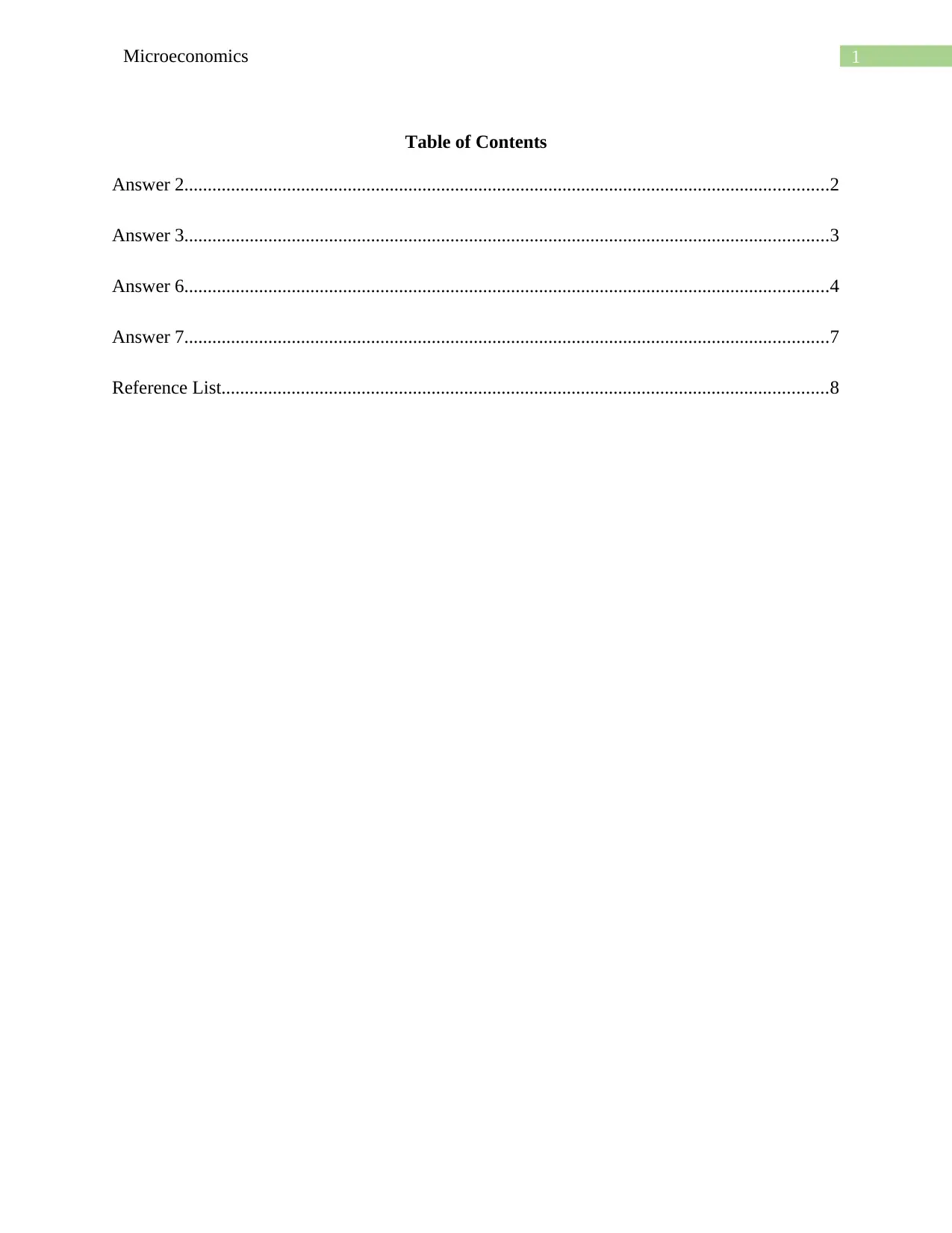
1Microeconomics
Table of Contents
Answer 2..........................................................................................................................................2
Answer 3..........................................................................................................................................3
Answer 6..........................................................................................................................................4
Answer 7..........................................................................................................................................7
Reference List..................................................................................................................................8
Table of Contents
Answer 2..........................................................................................................................................2
Answer 3..........................................................................................................................................3
Answer 6..........................................................................................................................................4
Answer 7..........................................................................................................................................7
Reference List..................................................................................................................................8
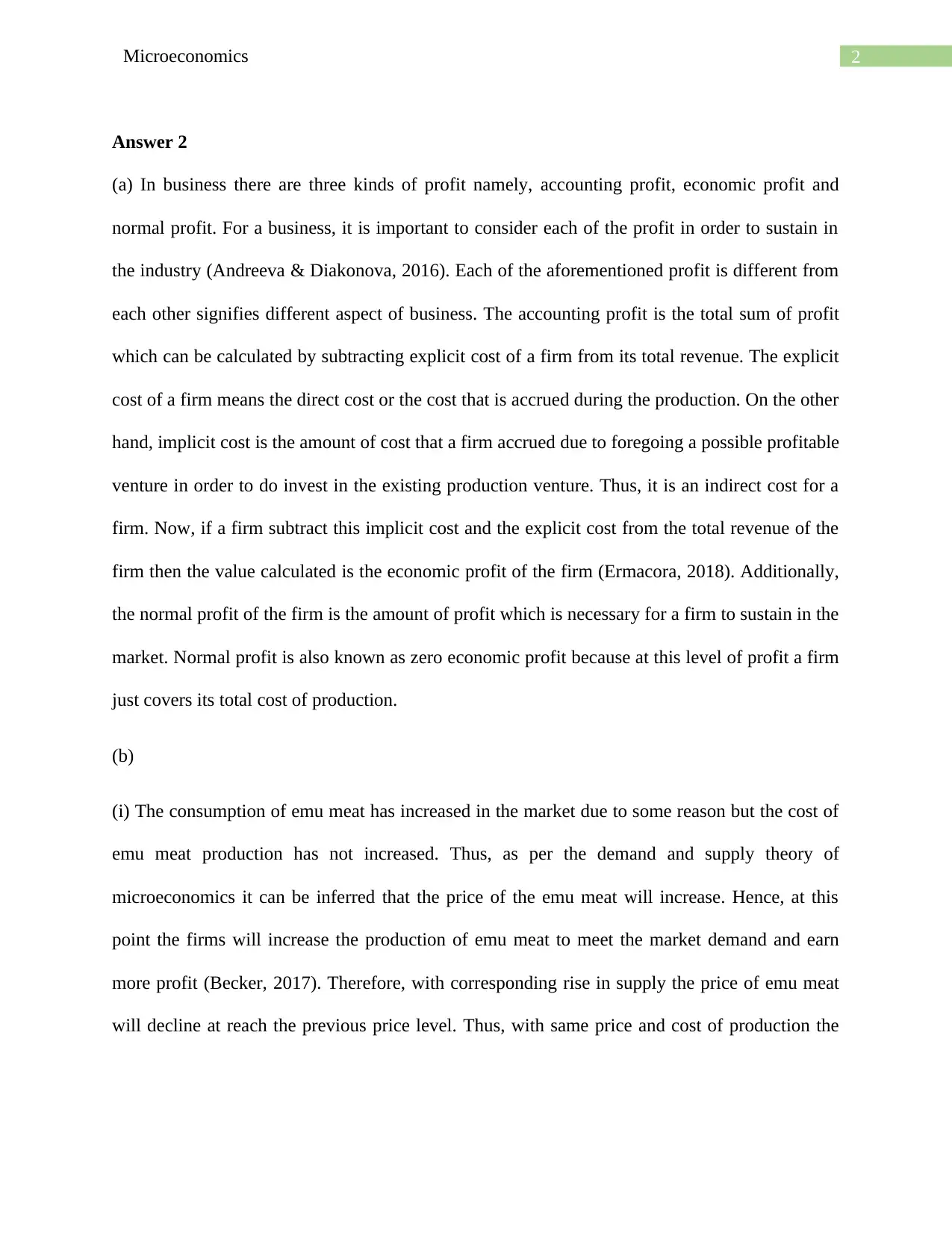
2Microeconomics
Answer 2
(a) In business there are three kinds of profit namely, accounting profit, economic profit and
normal profit. For a business, it is important to consider each of the profit in order to sustain in
the industry (Andreeva & Diakonova, 2016). Each of the aforementioned profit is different from
each other signifies different aspect of business. The accounting profit is the total sum of profit
which can be calculated by subtracting explicit cost of a firm from its total revenue. The explicit
cost of a firm means the direct cost or the cost that is accrued during the production. On the other
hand, implicit cost is the amount of cost that a firm accrued due to foregoing a possible profitable
venture in order to do invest in the existing production venture. Thus, it is an indirect cost for a
firm. Now, if a firm subtract this implicit cost and the explicit cost from the total revenue of the
firm then the value calculated is the economic profit of the firm (Ermacora, 2018). Additionally,
the normal profit of the firm is the amount of profit which is necessary for a firm to sustain in the
market. Normal profit is also known as zero economic profit because at this level of profit a firm
just covers its total cost of production.
(b)
(i) The consumption of emu meat has increased in the market due to some reason but the cost of
emu meat production has not increased. Thus, as per the demand and supply theory of
microeconomics it can be inferred that the price of the emu meat will increase. Hence, at this
point the firms will increase the production of emu meat to meet the market demand and earn
more profit (Becker, 2017). Therefore, with corresponding rise in supply the price of emu meat
will decline at reach the previous price level. Thus, with same price and cost of production the
Answer 2
(a) In business there are three kinds of profit namely, accounting profit, economic profit and
normal profit. For a business, it is important to consider each of the profit in order to sustain in
the industry (Andreeva & Diakonova, 2016). Each of the aforementioned profit is different from
each other signifies different aspect of business. The accounting profit is the total sum of profit
which can be calculated by subtracting explicit cost of a firm from its total revenue. The explicit
cost of a firm means the direct cost or the cost that is accrued during the production. On the other
hand, implicit cost is the amount of cost that a firm accrued due to foregoing a possible profitable
venture in order to do invest in the existing production venture. Thus, it is an indirect cost for a
firm. Now, if a firm subtract this implicit cost and the explicit cost from the total revenue of the
firm then the value calculated is the economic profit of the firm (Ermacora, 2018). Additionally,
the normal profit of the firm is the amount of profit which is necessary for a firm to sustain in the
market. Normal profit is also known as zero economic profit because at this level of profit a firm
just covers its total cost of production.
(b)
(i) The consumption of emu meat has increased in the market due to some reason but the cost of
emu meat production has not increased. Thus, as per the demand and supply theory of
microeconomics it can be inferred that the price of the emu meat will increase. Hence, at this
point the firms will increase the production of emu meat to meet the market demand and earn
more profit (Becker, 2017). Therefore, with corresponding rise in supply the price of emu meat
will decline at reach the previous price level. Thus, with same price and cost of production the
⊘ This is a preview!⊘
Do you want full access?
Subscribe today to unlock all pages.

Trusted by 1+ million students worldwide
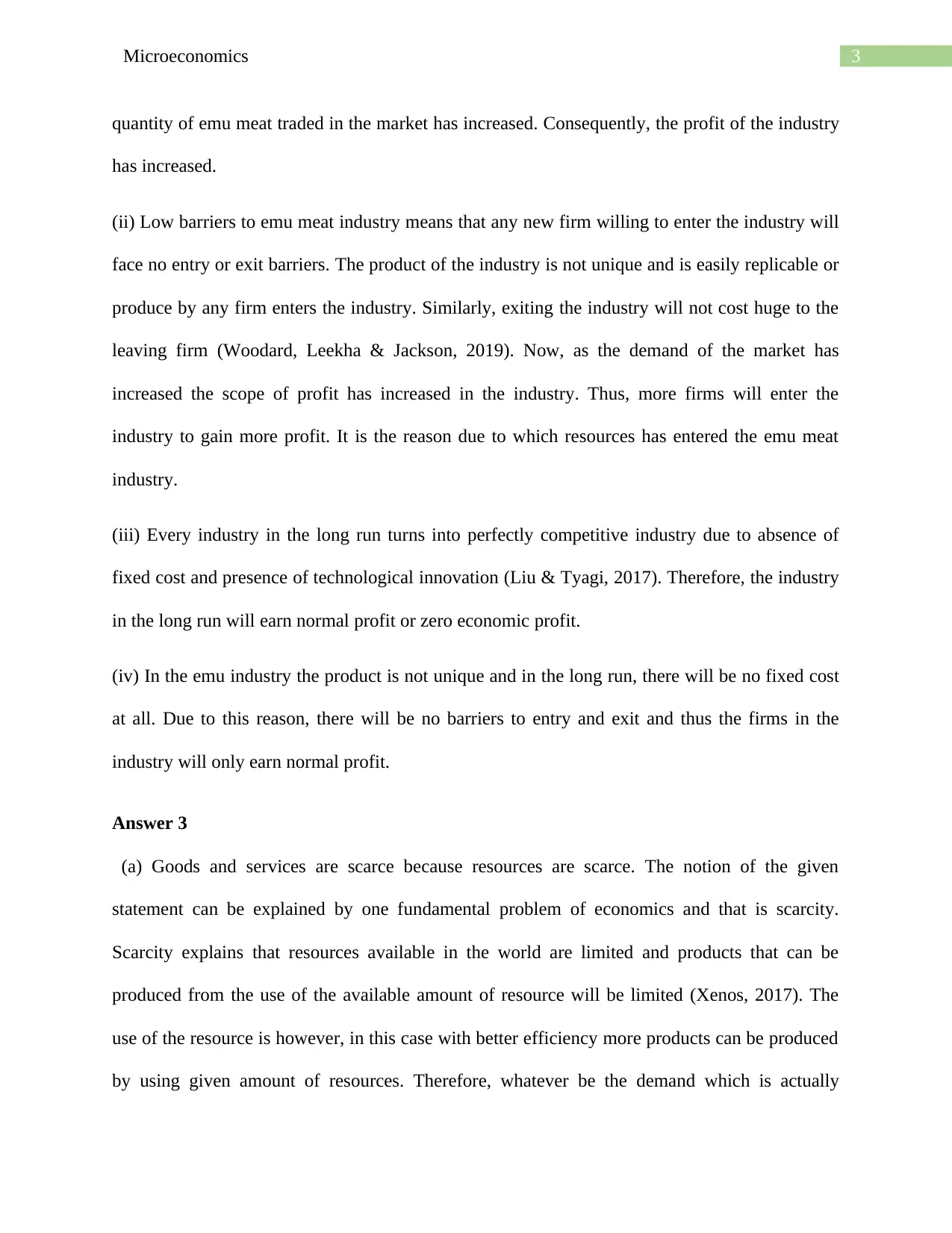
3Microeconomics
quantity of emu meat traded in the market has increased. Consequently, the profit of the industry
has increased.
(ii) Low barriers to emu meat industry means that any new firm willing to enter the industry will
face no entry or exit barriers. The product of the industry is not unique and is easily replicable or
produce by any firm enters the industry. Similarly, exiting the industry will not cost huge to the
leaving firm (Woodard, Leekha & Jackson, 2019). Now, as the demand of the market has
increased the scope of profit has increased in the industry. Thus, more firms will enter the
industry to gain more profit. It is the reason due to which resources has entered the emu meat
industry.
(iii) Every industry in the long run turns into perfectly competitive industry due to absence of
fixed cost and presence of technological innovation (Liu & Tyagi, 2017). Therefore, the industry
in the long run will earn normal profit or zero economic profit.
(iv) In the emu industry the product is not unique and in the long run, there will be no fixed cost
at all. Due to this reason, there will be no barriers to entry and exit and thus the firms in the
industry will only earn normal profit.
Answer 3
(a) Goods and services are scarce because resources are scarce. The notion of the given
statement can be explained by one fundamental problem of economics and that is scarcity.
Scarcity explains that resources available in the world are limited and products that can be
produced from the use of the available amount of resource will be limited (Xenos, 2017). The
use of the resource is however, in this case with better efficiency more products can be produced
by using given amount of resources. Therefore, whatever be the demand which is actually
quantity of emu meat traded in the market has increased. Consequently, the profit of the industry
has increased.
(ii) Low barriers to emu meat industry means that any new firm willing to enter the industry will
face no entry or exit barriers. The product of the industry is not unique and is easily replicable or
produce by any firm enters the industry. Similarly, exiting the industry will not cost huge to the
leaving firm (Woodard, Leekha & Jackson, 2019). Now, as the demand of the market has
increased the scope of profit has increased in the industry. Thus, more firms will enter the
industry to gain more profit. It is the reason due to which resources has entered the emu meat
industry.
(iii) Every industry in the long run turns into perfectly competitive industry due to absence of
fixed cost and presence of technological innovation (Liu & Tyagi, 2017). Therefore, the industry
in the long run will earn normal profit or zero economic profit.
(iv) In the emu industry the product is not unique and in the long run, there will be no fixed cost
at all. Due to this reason, there will be no barriers to entry and exit and thus the firms in the
industry will only earn normal profit.
Answer 3
(a) Goods and services are scarce because resources are scarce. The notion of the given
statement can be explained by one fundamental problem of economics and that is scarcity.
Scarcity explains that resources available in the world are limited and products that can be
produced from the use of the available amount of resource will be limited (Xenos, 2017). The
use of the resource is however, in this case with better efficiency more products can be produced
by using given amount of resources. Therefore, whatever be the demand which is actually
Paraphrase This Document
Need a fresh take? Get an instant paraphrase of this document with our AI Paraphraser
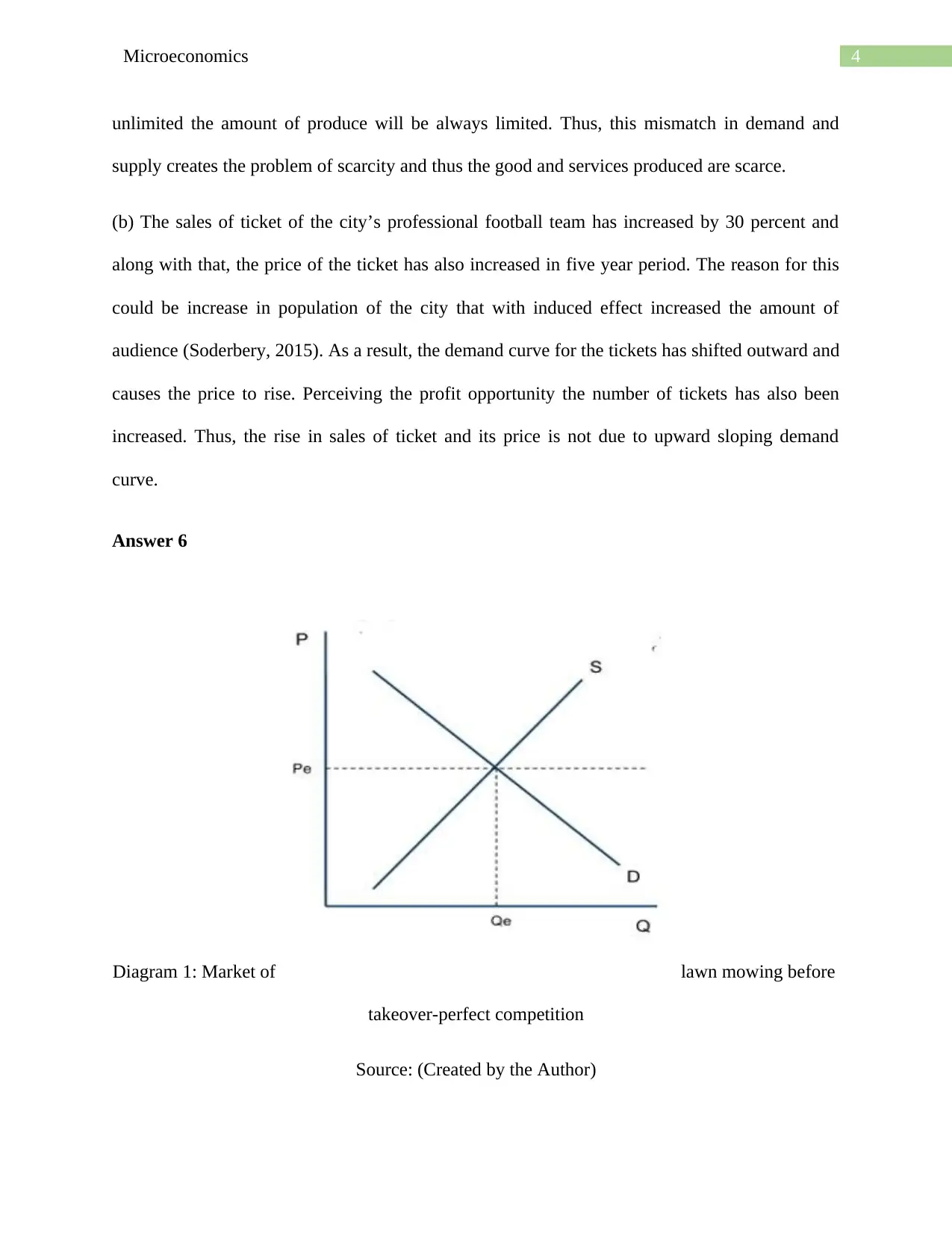
4Microeconomics
unlimited the amount of produce will be always limited. Thus, this mismatch in demand and
supply creates the problem of scarcity and thus the good and services produced are scarce.
(b) The sales of ticket of the city’s professional football team has increased by 30 percent and
along with that, the price of the ticket has also increased in five year period. The reason for this
could be increase in population of the city that with induced effect increased the amount of
audience (Soderbery, 2015). As a result, the demand curve for the tickets has shifted outward and
causes the price to rise. Perceiving the profit opportunity the number of tickets has also been
increased. Thus, the rise in sales of ticket and its price is not due to upward sloping demand
curve.
Answer 6
Diagram 1: Market of lawn mowing before
takeover-perfect competition
Source: (Created by the Author)
unlimited the amount of produce will be always limited. Thus, this mismatch in demand and
supply creates the problem of scarcity and thus the good and services produced are scarce.
(b) The sales of ticket of the city’s professional football team has increased by 30 percent and
along with that, the price of the ticket has also increased in five year period. The reason for this
could be increase in population of the city that with induced effect increased the amount of
audience (Soderbery, 2015). As a result, the demand curve for the tickets has shifted outward and
causes the price to rise. Perceiving the profit opportunity the number of tickets has also been
increased. Thus, the rise in sales of ticket and its price is not due to upward sloping demand
curve.
Answer 6
Diagram 1: Market of lawn mowing before
takeover-perfect competition
Source: (Created by the Author)
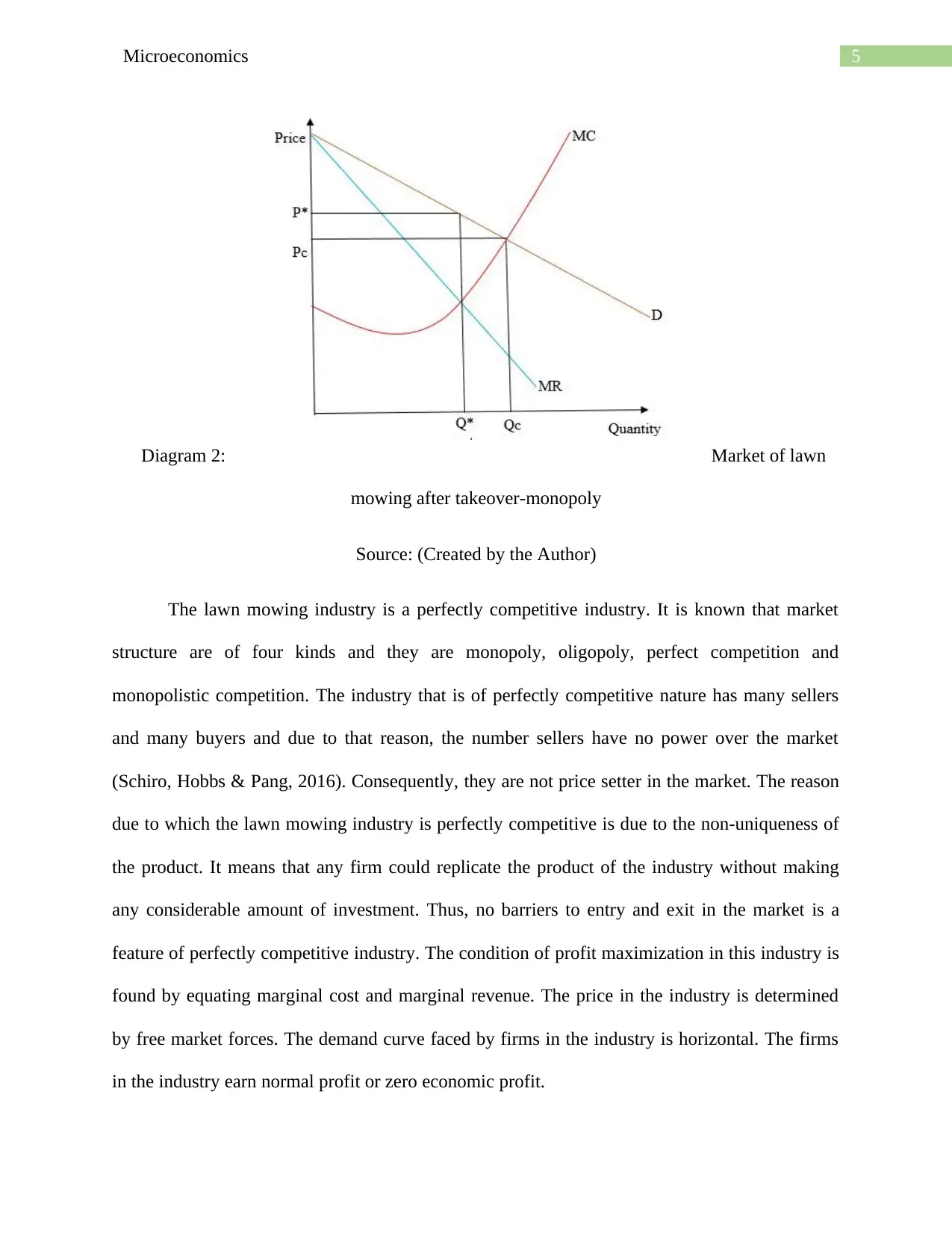
5Microeconomics
Diagram 2: Market of lawn
mowing after takeover-monopoly
Source: (Created by the Author)
The lawn mowing industry is a perfectly competitive industry. It is known that market
structure are of four kinds and they are monopoly, oligopoly, perfect competition and
monopolistic competition. The industry that is of perfectly competitive nature has many sellers
and many buyers and due to that reason, the number sellers have no power over the market
(Schiro, Hobbs & Pang, 2016). Consequently, they are not price setter in the market. The reason
due to which the lawn mowing industry is perfectly competitive is due to the non-uniqueness of
the product. It means that any firm could replicate the product of the industry without making
any considerable amount of investment. Thus, no barriers to entry and exit in the market is a
feature of perfectly competitive industry. The condition of profit maximization in this industry is
found by equating marginal cost and marginal revenue. The price in the industry is determined
by free market forces. The demand curve faced by firms in the industry is horizontal. The firms
in the industry earn normal profit or zero economic profit.
Diagram 2: Market of lawn
mowing after takeover-monopoly
Source: (Created by the Author)
The lawn mowing industry is a perfectly competitive industry. It is known that market
structure are of four kinds and they are monopoly, oligopoly, perfect competition and
monopolistic competition. The industry that is of perfectly competitive nature has many sellers
and many buyers and due to that reason, the number sellers have no power over the market
(Schiro, Hobbs & Pang, 2016). Consequently, they are not price setter in the market. The reason
due to which the lawn mowing industry is perfectly competitive is due to the non-uniqueness of
the product. It means that any firm could replicate the product of the industry without making
any considerable amount of investment. Thus, no barriers to entry and exit in the market is a
feature of perfectly competitive industry. The condition of profit maximization in this industry is
found by equating marginal cost and marginal revenue. The price in the industry is determined
by free market forces. The demand curve faced by firms in the industry is horizontal. The firms
in the industry earn normal profit or zero economic profit.
⊘ This is a preview!⊘
Do you want full access?
Subscribe today to unlock all pages.

Trusted by 1+ million students worldwide
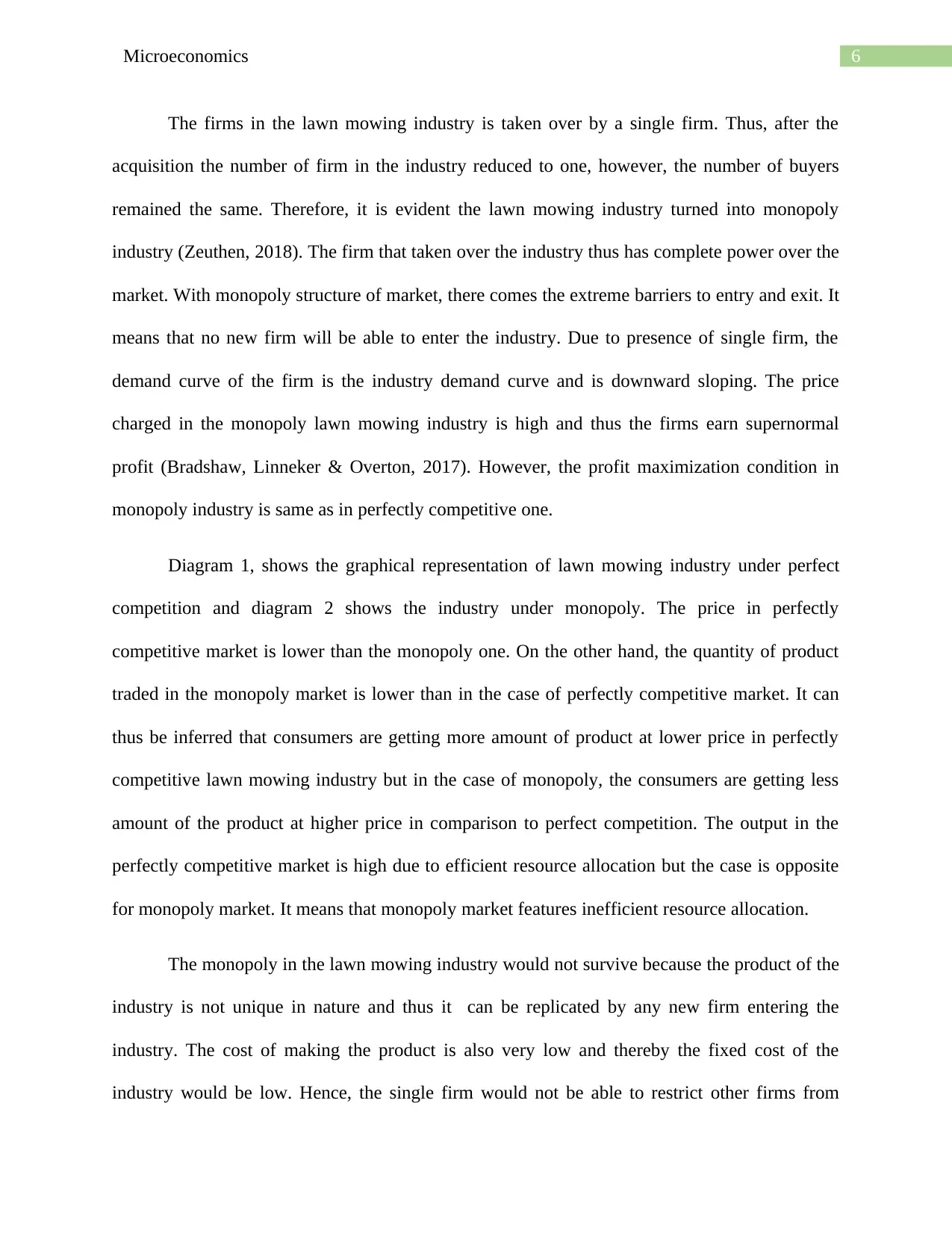
6Microeconomics
The firms in the lawn mowing industry is taken over by a single firm. Thus, after the
acquisition the number of firm in the industry reduced to one, however, the number of buyers
remained the same. Therefore, it is evident the lawn mowing industry turned into monopoly
industry (Zeuthen, 2018). The firm that taken over the industry thus has complete power over the
market. With monopoly structure of market, there comes the extreme barriers to entry and exit. It
means that no new firm will be able to enter the industry. Due to presence of single firm, the
demand curve of the firm is the industry demand curve and is downward sloping. The price
charged in the monopoly lawn mowing industry is high and thus the firms earn supernormal
profit (Bradshaw, Linneker & Overton, 2017). However, the profit maximization condition in
monopoly industry is same as in perfectly competitive one.
Diagram 1, shows the graphical representation of lawn mowing industry under perfect
competition and diagram 2 shows the industry under monopoly. The price in perfectly
competitive market is lower than the monopoly one. On the other hand, the quantity of product
traded in the monopoly market is lower than in the case of perfectly competitive market. It can
thus be inferred that consumers are getting more amount of product at lower price in perfectly
competitive lawn mowing industry but in the case of monopoly, the consumers are getting less
amount of the product at higher price in comparison to perfect competition. The output in the
perfectly competitive market is high due to efficient resource allocation but the case is opposite
for monopoly market. It means that monopoly market features inefficient resource allocation.
The monopoly in the lawn mowing industry would not survive because the product of the
industry is not unique in nature and thus it can be replicated by any new firm entering the
industry. The cost of making the product is also very low and thereby the fixed cost of the
industry would be low. Hence, the single firm would not be able to restrict other firms from
The firms in the lawn mowing industry is taken over by a single firm. Thus, after the
acquisition the number of firm in the industry reduced to one, however, the number of buyers
remained the same. Therefore, it is evident the lawn mowing industry turned into monopoly
industry (Zeuthen, 2018). The firm that taken over the industry thus has complete power over the
market. With monopoly structure of market, there comes the extreme barriers to entry and exit. It
means that no new firm will be able to enter the industry. Due to presence of single firm, the
demand curve of the firm is the industry demand curve and is downward sloping. The price
charged in the monopoly lawn mowing industry is high and thus the firms earn supernormal
profit (Bradshaw, Linneker & Overton, 2017). However, the profit maximization condition in
monopoly industry is same as in perfectly competitive one.
Diagram 1, shows the graphical representation of lawn mowing industry under perfect
competition and diagram 2 shows the industry under monopoly. The price in perfectly
competitive market is lower than the monopoly one. On the other hand, the quantity of product
traded in the monopoly market is lower than in the case of perfectly competitive market. It can
thus be inferred that consumers are getting more amount of product at lower price in perfectly
competitive lawn mowing industry but in the case of monopoly, the consumers are getting less
amount of the product at higher price in comparison to perfect competition. The output in the
perfectly competitive market is high due to efficient resource allocation but the case is opposite
for monopoly market. It means that monopoly market features inefficient resource allocation.
The monopoly in the lawn mowing industry would not survive because the product of the
industry is not unique in nature and thus it can be replicated by any new firm entering the
industry. The cost of making the product is also very low and thereby the fixed cost of the
industry would be low. Hence, the single firm would not be able to restrict other firms from
Paraphrase This Document
Need a fresh take? Get an instant paraphrase of this document with our AI Paraphraser
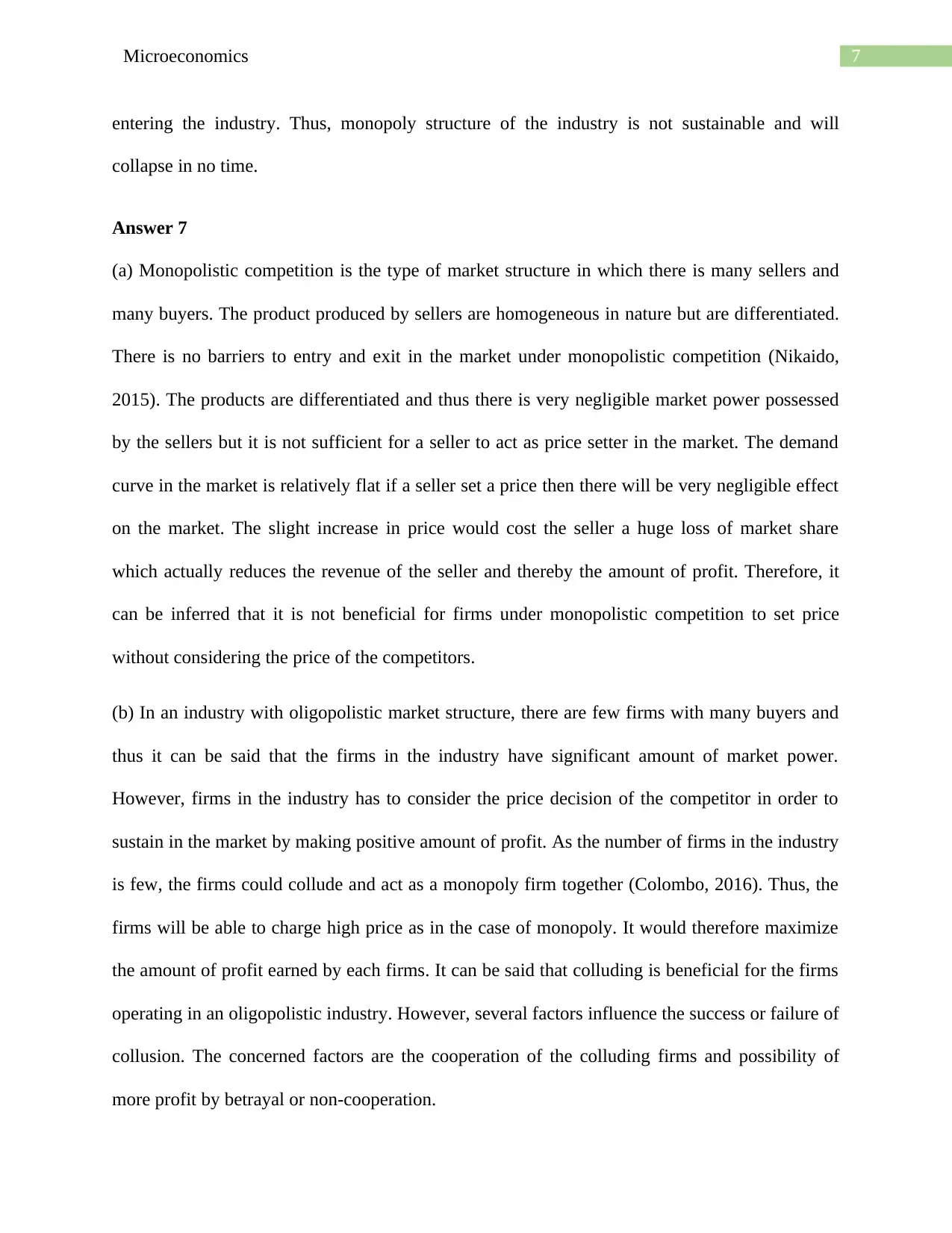
7Microeconomics
entering the industry. Thus, monopoly structure of the industry is not sustainable and will
collapse in no time.
Answer 7
(a) Monopolistic competition is the type of market structure in which there is many sellers and
many buyers. The product produced by sellers are homogeneous in nature but are differentiated.
There is no barriers to entry and exit in the market under monopolistic competition (Nikaido,
2015). The products are differentiated and thus there is very negligible market power possessed
by the sellers but it is not sufficient for a seller to act as price setter in the market. The demand
curve in the market is relatively flat if a seller set a price then there will be very negligible effect
on the market. The slight increase in price would cost the seller a huge loss of market share
which actually reduces the revenue of the seller and thereby the amount of profit. Therefore, it
can be inferred that it is not beneficial for firms under monopolistic competition to set price
without considering the price of the competitors.
(b) In an industry with oligopolistic market structure, there are few firms with many buyers and
thus it can be said that the firms in the industry have significant amount of market power.
However, firms in the industry has to consider the price decision of the competitor in order to
sustain in the market by making positive amount of profit. As the number of firms in the industry
is few, the firms could collude and act as a monopoly firm together (Colombo, 2016). Thus, the
firms will be able to charge high price as in the case of monopoly. It would therefore maximize
the amount of profit earned by each firms. It can be said that colluding is beneficial for the firms
operating in an oligopolistic industry. However, several factors influence the success or failure of
collusion. The concerned factors are the cooperation of the colluding firms and possibility of
more profit by betrayal or non-cooperation.
entering the industry. Thus, monopoly structure of the industry is not sustainable and will
collapse in no time.
Answer 7
(a) Monopolistic competition is the type of market structure in which there is many sellers and
many buyers. The product produced by sellers are homogeneous in nature but are differentiated.
There is no barriers to entry and exit in the market under monopolistic competition (Nikaido,
2015). The products are differentiated and thus there is very negligible market power possessed
by the sellers but it is not sufficient for a seller to act as price setter in the market. The demand
curve in the market is relatively flat if a seller set a price then there will be very negligible effect
on the market. The slight increase in price would cost the seller a huge loss of market share
which actually reduces the revenue of the seller and thereby the amount of profit. Therefore, it
can be inferred that it is not beneficial for firms under monopolistic competition to set price
without considering the price of the competitors.
(b) In an industry with oligopolistic market structure, there are few firms with many buyers and
thus it can be said that the firms in the industry have significant amount of market power.
However, firms in the industry has to consider the price decision of the competitor in order to
sustain in the market by making positive amount of profit. As the number of firms in the industry
is few, the firms could collude and act as a monopoly firm together (Colombo, 2016). Thus, the
firms will be able to charge high price as in the case of monopoly. It would therefore maximize
the amount of profit earned by each firms. It can be said that colluding is beneficial for the firms
operating in an oligopolistic industry. However, several factors influence the success or failure of
collusion. The concerned factors are the cooperation of the colluding firms and possibility of
more profit by betrayal or non-cooperation.
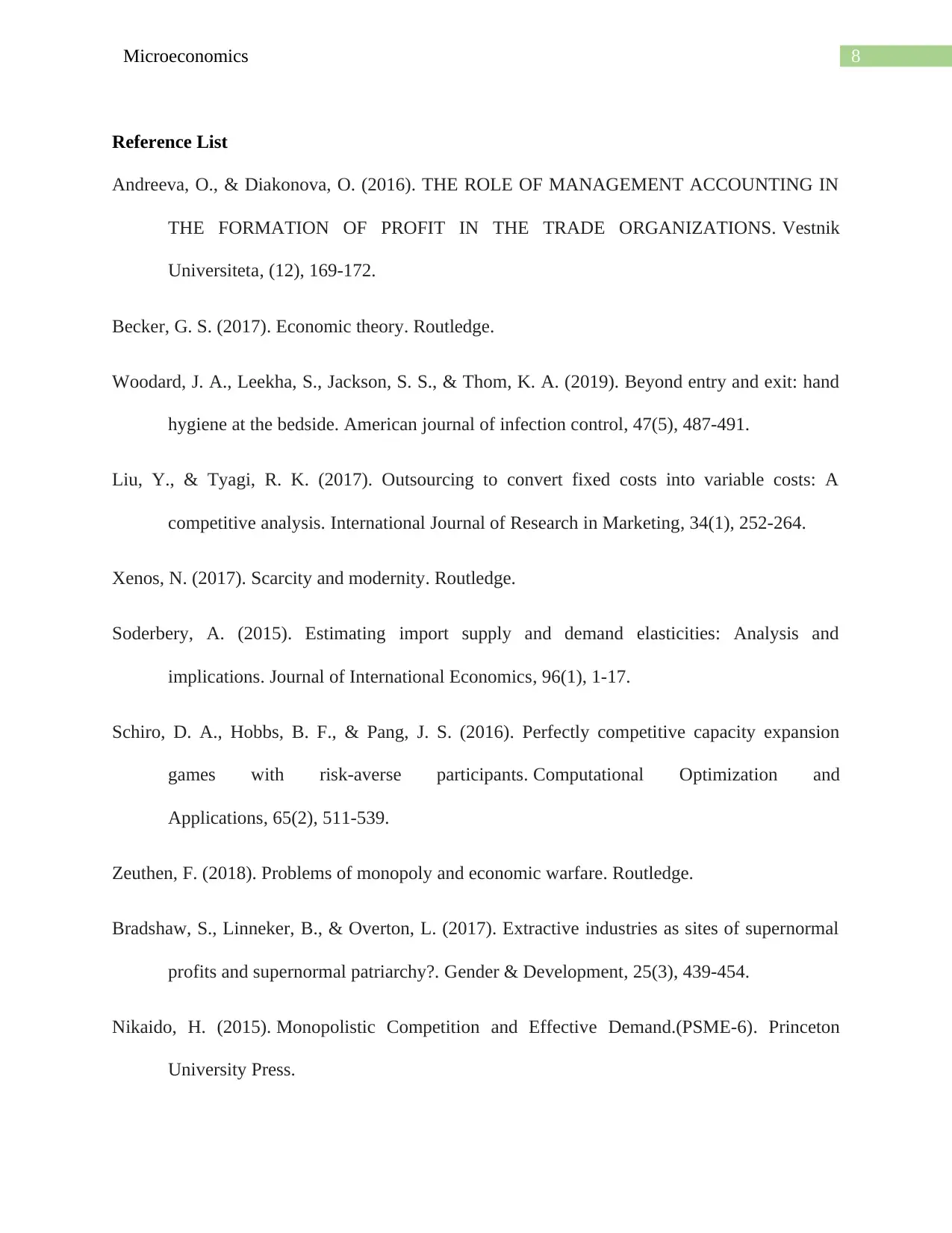
8Microeconomics
Reference List
Andreeva, O., & Diakonova, O. (2016). THE ROLE OF MANAGEMENT ACCOUNTING IN
THE FORMATION OF PROFIT IN THE TRADE ORGANIZATIONS. Vestnik
Universiteta, (12), 169-172.
Becker, G. S. (2017). Economic theory. Routledge.
Woodard, J. A., Leekha, S., Jackson, S. S., & Thom, K. A. (2019). Beyond entry and exit: hand
hygiene at the bedside. American journal of infection control, 47(5), 487-491.
Liu, Y., & Tyagi, R. K. (2017). Outsourcing to convert fixed costs into variable costs: A
competitive analysis. International Journal of Research in Marketing, 34(1), 252-264.
Xenos, N. (2017). Scarcity and modernity. Routledge.
Soderbery, A. (2015). Estimating import supply and demand elasticities: Analysis and
implications. Journal of International Economics, 96(1), 1-17.
Schiro, D. A., Hobbs, B. F., & Pang, J. S. (2016). Perfectly competitive capacity expansion
games with risk-averse participants. Computational Optimization and
Applications, 65(2), 511-539.
Zeuthen, F. (2018). Problems of monopoly and economic warfare. Routledge.
Bradshaw, S., Linneker, B., & Overton, L. (2017). Extractive industries as sites of supernormal
profits and supernormal patriarchy?. Gender & Development, 25(3), 439-454.
Nikaido, H. (2015). Monopolistic Competition and Effective Demand.(PSME-6). Princeton
University Press.
Reference List
Andreeva, O., & Diakonova, O. (2016). THE ROLE OF MANAGEMENT ACCOUNTING IN
THE FORMATION OF PROFIT IN THE TRADE ORGANIZATIONS. Vestnik
Universiteta, (12), 169-172.
Becker, G. S. (2017). Economic theory. Routledge.
Woodard, J. A., Leekha, S., Jackson, S. S., & Thom, K. A. (2019). Beyond entry and exit: hand
hygiene at the bedside. American journal of infection control, 47(5), 487-491.
Liu, Y., & Tyagi, R. K. (2017). Outsourcing to convert fixed costs into variable costs: A
competitive analysis. International Journal of Research in Marketing, 34(1), 252-264.
Xenos, N. (2017). Scarcity and modernity. Routledge.
Soderbery, A. (2015). Estimating import supply and demand elasticities: Analysis and
implications. Journal of International Economics, 96(1), 1-17.
Schiro, D. A., Hobbs, B. F., & Pang, J. S. (2016). Perfectly competitive capacity expansion
games with risk-averse participants. Computational Optimization and
Applications, 65(2), 511-539.
Zeuthen, F. (2018). Problems of monopoly and economic warfare. Routledge.
Bradshaw, S., Linneker, B., & Overton, L. (2017). Extractive industries as sites of supernormal
profits and supernormal patriarchy?. Gender & Development, 25(3), 439-454.
Nikaido, H. (2015). Monopolistic Competition and Effective Demand.(PSME-6). Princeton
University Press.
⊘ This is a preview!⊘
Do you want full access?
Subscribe today to unlock all pages.

Trusted by 1+ million students worldwide
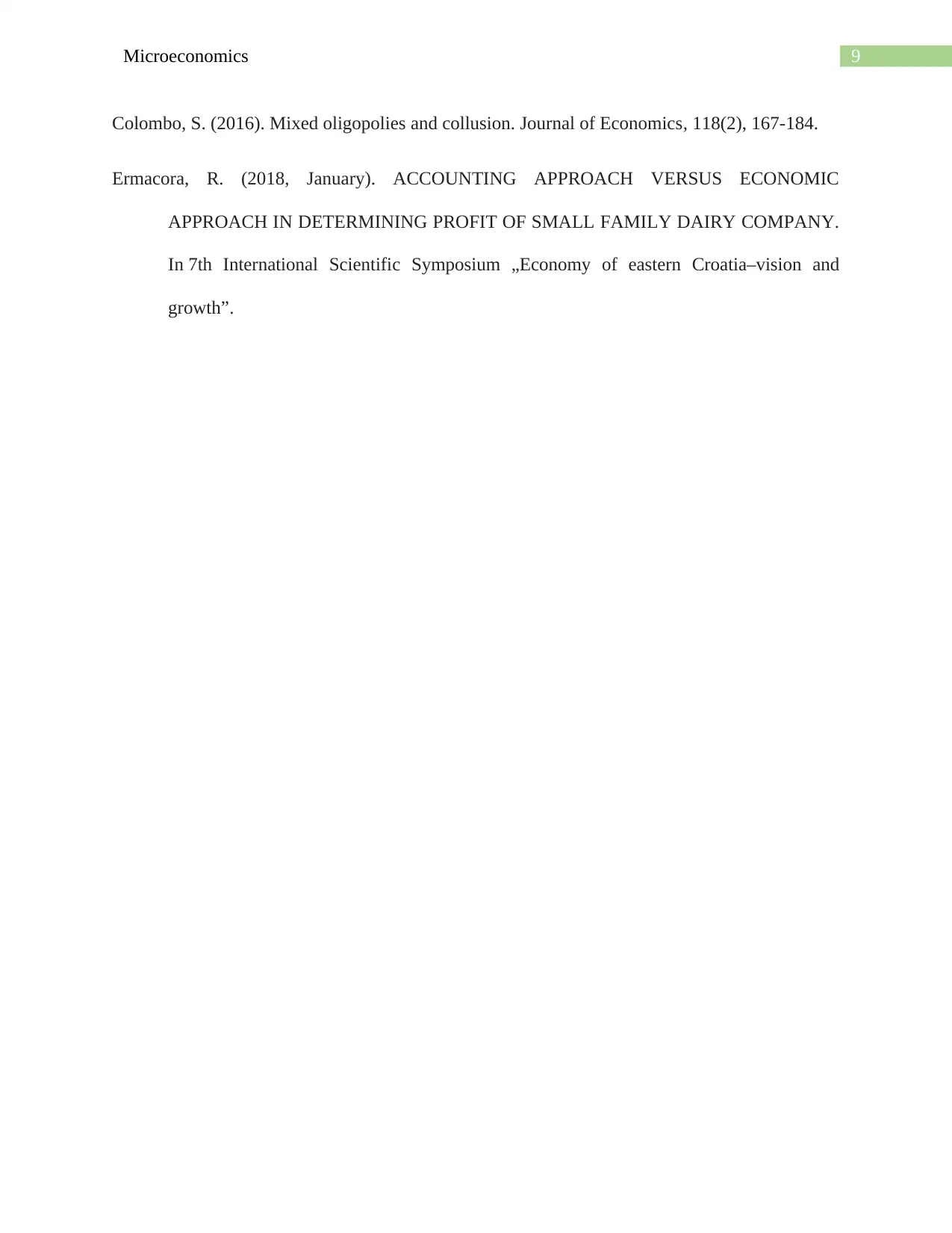
9Microeconomics
Colombo, S. (2016). Mixed oligopolies and collusion. Journal of Economics, 118(2), 167-184.
Ermacora, R. (2018, January). ACCOUNTING APPROACH VERSUS ECONOMIC
APPROACH IN DETERMINING PROFIT OF SMALL FAMILY DAIRY COMPANY.
In 7th International Scientific Symposium „Economy of eastern Croatia–vision and
growth”.
Colombo, S. (2016). Mixed oligopolies and collusion. Journal of Economics, 118(2), 167-184.
Ermacora, R. (2018, January). ACCOUNTING APPROACH VERSUS ECONOMIC
APPROACH IN DETERMINING PROFIT OF SMALL FAMILY DAIRY COMPANY.
In 7th International Scientific Symposium „Economy of eastern Croatia–vision and
growth”.
1 out of 10
Related Documents
Your All-in-One AI-Powered Toolkit for Academic Success.
+13062052269
info@desklib.com
Available 24*7 on WhatsApp / Email
![[object Object]](/_next/static/media/star-bottom.7253800d.svg)
Unlock your academic potential
Copyright © 2020–2025 A2Z Services. All Rights Reserved. Developed and managed by ZUCOL.





